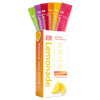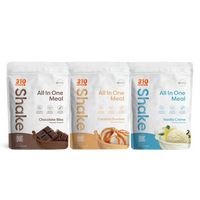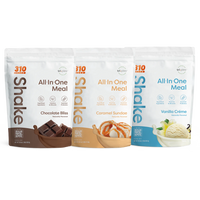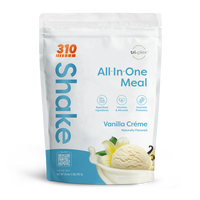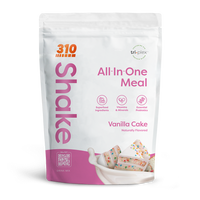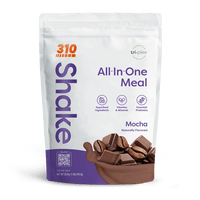Thanksgiving is a time of yearly celebration with family and friends, to refocus on everything you’re grateful for, and indulge in some good food and company. There’s absolutely no reason why you shouldn’t enjoy it, and in fact, there are plenty of healthy Thanksgiving dishes that you can still savor, that also help fuel your body and keep you on track with your goals.
In this article, we’ll give ideas for several delicious yet healthy recipes to enjoy this Thanksgiving, and any other time you desire! But before we dive into that, let's take a moment to understand why having a healthy Thanksgiving feast is so important!
The Importance of a Healthy Thanksgiving Feast
When you’re ready to start arranging your lifestyle to be healthier, this mindset shouldn’t stop for every holiday or special day, instead, you can still carry that mindset through, to make the day both enjoyable and nutritious. Here’s how:
Nutritional Balance: Traditional Thanksgiving dinners usually have high calorie, fat, and sugar content. By organizing a healthier Thanksgiving feast, you can ensure that guests obtain a variety of nutrients that are vital for their general health, such as fiber, protein, and vitamins and minerals.
Calorie Intake: Eating too many calories from traditional Thanksgiving dishes can be a problem if you’re trying to lose or manage your weight, or manage medical issues like diabetes or heart disease. A healthy approach helps keep those calories in-check without sacrificing the enjoyment of the holiday.
Good Food Habits: Presenting a nutritious Thanksgiving meal may motivate visitors to make better food choices throughout their lives. It demonstrates that nutritious food can also still be filling and taste good.
Digestive Comfort: Consuming rich foods in excess can cause discomfort to the digestive system. Eating healthier selections can help minimize the occurrence of indigestion, bloating, and fatigue that are frequently linked to large meals. [1]
Mindful Eating: A feast with an emphasis on health gives visitors a chance to be more aware of what they’re eating. A better understanding of portion control and the tastes and textures of the meal might result from practicing mindfulness.
10 Tips for a Healthy Thanksgiving Feast

Putting together a healthy Thanksgiving feast involves making mindful choices and incorporating nutritious options. Here are ten healthy Thanksgiving tips to help get you started:
- Start With Healthy Appetizers: Start with a selection of appetizers, such as raw vegetable platters and fresh salads. In addition to being nutrient-dense, they also aid in controlling appetite, which helps you curb overindulging when the main dish is served. Including a variety of vibrant veggies in your diet also supplies you with important vitamins and minerals. [2]
- Opt for Lean Protein: Steer clear of the skin and opt for lean turkey pieces, particularly the breast meat. Cooking techniques that lower the total fat content, such as roasting or grilling, are better than frying. This adds health benefits to your protein selection without compromising taste.
- Use Whole Grains: Use whole grains instead of refined grains and white bread in casseroles, side dishes, and stuffing. More fiber and nutrients are found in whole grains, which are beneficial for digestion and necessary for a balanced diet. [3]
- Focus on Vegetables and Fruits: Include a lot of vegetables and fruits in your meals. Try to have half of your plate consist of different vibrant vegetables that have been cooked in healthful ways, such as roasting or steaming. This method helps you control your calorie consumption in addition to providing your diet with fiber and other necessary nutrients.
- Control Portion Sizes: It's critical to regulate portion sizes. You can naturally eat less while still enjoying a variety of cuisines if you use smaller plates. You can taste everything with this tactic without running the risk of overindulging.
- Enjoy Healthier Sweets: Instead of reaching for candies or cakes, try fruit-based sweets or recipes that have been adjusted to include healthier fats and less sugar. For example, a pumpkin pie can be cooked with less sugar and a whole-wheat crust, which is still delicious and healthy.
- Choose Smart Beverages: Choose hydrates, lemonade mix, herbal teas, or water in place of sugary beverages or copious amounts of alcohol. These options let you control your sugar and calorie intake throughout the feast, while also keeping you hydrated.
- Add Herbs and Spices for Flavor: Rather than depending solely on butter and salt, add a range of herbs and spices to add more flavor to your food! Many herbs and spices have antioxidant qualities, which helps enhance the flavor while also having health advantages.
- Repurpose Leftovers: Make plans for nourishing ways to repurpose leftovers, including adding more turkey to soups or salads and storing some of the veggies for easy, nutrient-dense meals that can last over the next several days.
- Get Active: Make time during your day for some physical activity. Engaging in physical activity, such as going for a family stroll, playing touch football, or having a fun dance-off, can help counterbalance calorie intake and strengthen relationships with loved ones.
7 Healthy Recipes for Your Thanksgiving Feast
Next, we’ve put together seven healthy recipes to incorporate into your Thanksgiving feast. From succulent roasted turkey breast to nutritious quinoa stuffing and indulgent, yet guilt-free, chocolate protein brownies, these recipes are designed to delight your taste buds while keeping your health top of mind:
#1 Roasted Turkey Breast

Roasted turkey breast is a classic dish often featured in Thanksgiving and other holiday meals. It involves roasting the breast of a turkey, which is known for its lean, white meat.
Ingredients
- Boneless turkey breast
- Olive oil, garlic
- Fresh herbs (rosemary, thyme, sage)
- Salt
- Pepper
Instructions
- Preheat your oven to 350°F (175°C).
- Take the turkey breast and pat it dry with paper towels. (This helps the seasonings stick better and aids in crisping the skin.)
- Rub the turkey breast all over with olive oil. Olive oil helps keep the meat moist and adds flavor.
- Finely mince fresh garlic and chop up your choice of herbs (such as rosemary, thyme, or sage). Rub this mixture onto the turkey breast. The garlic and herbs will infuse the meat with aromatic flavors.
- Season the turkey breast generously with salt and pepper to enhance the natural flavors of the turkey and the herbs.
- Place the seasoned turkey breast in a roasting pan.
- Roast the turkey in the preheated oven. The cooking time will depend on the size of the breast, but generally, it takes about 20 minutes per pound.
- Check the internal temperature of the turkey breast with a meat thermometer. It's ready when it reaches an internal temperature of 165°F (74°C). This temperature ensures the turkey is cooked thoroughly and safe to eat.
- Once the turkey breast reaches the correct temperature, remove it from the oven.
- Let the turkey breast rest for about 10-15 minutes before slicing. Resting allows the juices to redistribute, ensuring the meat is moist and flavorful when carved.
#2 Quinoa Stuffing
 Quinoa stuffing is a healthy and modern twist on the traditional stuffing that is often used as a side dish in Thanksgiving meals. Instead of using bread as the base, this recipe uses quinoa, a nutritious and gluten-free grain known for its high protein content and rich supply of essential amino acids.
Quinoa stuffing is a healthy and modern twist on the traditional stuffing that is often used as a side dish in Thanksgiving meals. Instead of using bread as the base, this recipe uses quinoa, a nutritious and gluten-free grain known for its high protein content and rich supply of essential amino acids.- Cooked quinoa
- Diced onions
- Celery
- Carrots
- Dried cranberries
- Chopped nuts
- Vegetable broth
- Seasonings
Instructions
- Start by finely chopping onions, celery, and carrots.
- Heat some olive oil in a large skillet and sauté the chopped onions, celery, and carrots until they are soft and lightly browned.
- In a separate pot, cook the quinoa as per the package instructions until it's fluffy and fully cooked.
- Once the quinoa is cooked, combine with the sautéed vegetables in a large mixing bowl.
- Add dried cranberries and your choice of chopped nuts (like walnuts or pecans) to the quinoa and vegetable mixture.
- Pour in vegetable or chicken broth to moisten the mixture. The amount of broth needed can vary, but you want the mixture to be moist, not soggy.
- Season the mixture with your desired herbs and spices. Common choices include sage, thyme, rosemary, salt, and pepper.
- Transfer the mixture to a baking dish and spread it evenly.
- Bake in a preheated oven at around 350°F (175°C) until the top is golden brown and the edges are slightly crispy, which usually takes about 25-30 minutes.
#3 Steamed Green Beans with Almonds

Steamed green beans with almonds is a simple, healthy, and elegant side dish often served at Thanksgiving and other special occasions. This dish is made by steaming fresh green beans until they are tender, yet crisp, preserving their vibrant color and natural nutrients.
Ingredients
- Fresh green beans
- Sliced almonds
- Lemon juice
- Garlic
- Salt
- Pepper
Instructions
- Steam the green beans until they are tender. This typically takes about 5-7 minutes depending on the thickness of the beans.
- While the beans are steaming, sauté sliced almonds and minced garlic in a pan. This should be done over medium heat until the almonds are lightly browned and the garlic is fragrant.
- Once the green beans are tender, remove them from the steamer and add them to the pan with the almonds and garlic.
- Toss everything together in the pan to ensure the green beans are evenly coated with the garlic and almonds.
- Drizzle lemon juice over the green beans and almonds, then season with salt and pepper to taste. The lemon juice adds a fresh, zesty flavor that complements the nuttiness of the almonds and the savory garlic.
- Give everything a final toss to evenly distribute the lemon juice, salt, and pepper, then serve while warm.
#4 Sweet Potato Casserole

Sweet potato casserole is a beloved traditional dish that’s often served during Thanksgiving and other holiday meals. It typically involves mashing up cooked sweet potatoes and mixing them with ingredients like butter, milk, cinnamon, and sometimes a bit of sugar or maple syrup for added sweetness, but we’re going to skip the marshmallows and butter for a healthier twist!
Ingredients
- Sweet potatoes
- Cinnamon
- Nutmeg
- A touch of maple syrup
- Chopped pecans for topping
Instructions
- Boil sweet potatoes until they are soft and fully cooked. This typically takes about 30-40 minutes depending on the size of the potatoes.
- Once the sweet potatoes are cooked, drain them and let them cool slightly for easier handling.
- Peel the sweet potatoes and place them in a large mixing bowl.
- Mash the sweet potatoes using a potato masher or a fork until they are smooth.
- Add cinnamon, nutmeg, and maple syrup to the mashed sweet potatoes. The amount can be adjusted according to taste preference.
- Mix everything together thoroughly to ensure the spices and maple syrup are evenly distributed throughout the mashed sweet potatoes.
- Preheat your oven to a baking temperature of around 350°F (175°C).
- Transfer the mashed sweet potato mixture into a baking dish.
- Sprinkle a layer of chopped pecans on top of the mashed sweet potatoes. The pecans will add a nice crunch and nutty flavor to the dish.
- Place the baking dish in the preheated oven and bake until the pecans on top become crunchy and the sweet potatoes are heated through. This usually takes about 20-30 minutes.
- Once done, remove the dish from the oven and let it cool slightly before serving.
#5 Cranberry Sauce
 Cranberry sauce is a popular condiment traditionally served in North America with Thanksgiving and Christmas meals. Made primarily from fresh cranberries, this sauce is known for its unique tart and sweet flavor, which pairs exceptionally well with rich meats like turkey.
Cranberry sauce is a popular condiment traditionally served in North America with Thanksgiving and Christmas meals. Made primarily from fresh cranberries, this sauce is known for its unique tart and sweet flavor, which pairs exceptionally well with rich meats like turkey.
Ingredients
- Fresh cranberries
- Orange juice
- Zest of an orange
- Honey or maple syrup
Instructions
- Rinse fresh cranberries under cold water and remove any damaged or soft berries. Grate enough orange peel to get the desired amount of zest.
- Place the cranberries in a medium saucepan. Add the orange zest and pour in enough orange juice to cover the berries, usually about a cup or so, depending on the quantity of cranberries. Stir in your chosen sweetener, like sugar, honey, or maple syrup, according to your taste preference.
- Bring the mixture to a simmer over medium heat, stirring occasionally to ensure even cooking and to prevent sticking.
- Keep simmering gently. The cranberries will start to burst open as they cook, which typically takes around 10-15 minutes. As the cranberries burst, they release natural pectin, which will help to thicken the sauce.
- Continue cooking until the sauce reaches your desired thickness. Keep in mind that the sauce will thicken further as it cools down.
- Once the cranberry sauce is done, remove it from the heat. Let it cool to room temperature, and then refrigerate it until you're ready to serve.
#6 Pumpkin Soup
 Pumpkin soup is a warm, creamy, and comforting seasonal dish often associated with many autumn and winter meals, including Thanksgiving. It is especially popular due to its smooth texture and rich, earthy flavors that embody the essence of fall.
Pumpkin soup is a warm, creamy, and comforting seasonal dish often associated with many autumn and winter meals, including Thanksgiving. It is especially popular due to its smooth texture and rich, earthy flavors that embody the essence of fall.
Ingredients
- Pumpkin puree
- Vegetable broth
- Onion
- Garlic
- Coconut milk
- Seasonings
Instructions
- Start by sautéeing chopped onion and minced garlic in a pot until the onion becomes translucent and the garlic is fragrant.
- Add pumpkin puree to the pot. This can be either homemade or canned pumpkin puree.
- Pour in vegetable or chicken broth, enough to achieve the desired consistency of the soup.
- Allow the mixture to simmer, letting the flavors meld together. This usually takes about 15-20 minutes.
- After simmering, use an immersion blender to blend the mixture in the pot until smooth. Alternatively, you can transfer it to a regular blender to blend until smooth, but be careful with the hot liquid.
- Once the soup is smooth, stir in coconut milk for a creamy texture. This also adds a subtle sweetness and richness to the soup.
- Season the soup according to taste with salt, pepper, and other preferred spices like cinnamon or nutmeg.
- Heat everything together for a few more minutes, then serve hot.
#7 Chocolate Protein Brownies
 These chocolate protein brownies are a healthier twist on the classic brownie by incorporating protein powder to boost their nutritional value. They're an excellent choice if you’re looking to enjoy a sweet treat while also maintaining a balanced diet and supporting your fitness goals.
These chocolate protein brownies are a healthier twist on the classic brownie by incorporating protein powder to boost their nutritional value. They're an excellent choice if you’re looking to enjoy a sweet treat while also maintaining a balanced diet and supporting your fitness goals.
Ingredients
- 1 cup almond flour
- 2 scoops 310 Chocolate Bliss Shake
- ¼ cup cocoa powder
- ½ tsp baking powder
- 2 eggs
- ¼ cup almond milk
- ¼ cup honey or maple syrup
- ½ cup unsweetened applesauce
Instructions
- Preheat your oven to 350°F and line a baking pan with parchment paper.
- In a bowl, mix together the almond flour, 310 Chocolate Bliss Shake, cocoa powder, and baking powder.
- In a separate bowl, whisk the eggs, almond milk, honey/maple syrup, and applesauce.
- Combine the wet and dry ingredients, stirring until just mixed.
- Pour the batter into the prepared pan and smooth out the top.
- Bake for 20-25 minutes or until a toothpick inserted in the center comes out clean.
- Let cool before slicing into squares.
FAQs on Thanksgiving Feast
What event inspired today's tradition of the Thanksgiving feast?
Today's tradition of the Thanksgiving feast is inspired by the 1621 harvest meal shared by the English Pilgrims of Plymouth and the Wampanoag people. This event is commonly regarded as America's "first Thanksgiving." It was a three-day feast to celebrate a successful growing season and to express gratitude for a good harvest. This historic gathering laid the foundation for the Thanksgiving holiday we observe today, symbolizing cooperation, gratitude, and the celebration of abundance.
How long did the original Thanksgiving feast last?
The original Thanksgiving feast, which was shared by the Pilgrims and the Wampanoag people in 1621, lasted for three days. This extended celebration was marked by shared meals, games, and activities, reflecting a moment of peace and collaboration between the two groups. This multi-day event stands in contrast to the single-day observance we are familiar with today.
What is the best Thanksgiving food?
Although opinions on the best Thanksgiving cuisine are subjective and vary from person to person, roast turkey is frequently regarded as the meal's iconic focal point. When cooked to perfection, its tasty and luscious meat perfectly embodies the spirit of the occasion. Thanksgiving is also made even more wonderful by the traditional side dishes, which include homemade cranberry sauce, stuffing, and creamy mashed potatoes.
Final Thoughts
In conclusion, as you can see, celebrating Thanksgiving in healthy ways can be both satisfying and enjoyable! Focusing on moderation, incorporating a variety of colorful vegetables, opting for leaner protein sources, and staying mindful of portion control, can make the feast more nutritious and enjoyable. Additionally, staying active and incorporating physical activities into the holiday can balance out the indulgence. Remember, Thanksgiving is not just about the food: It's also a time to express gratitude and connect with loved ones. By making mindful choices and savoring the experience, you can strike a balance between tradition and wellness during this holiday.
Reference:
- Valussi, M. (2012). Functional foods with digestion-enhancing properties. International Journal of Food Sciences and Nutrition, 63(sup1), 82-89.https://doi.org/10.3109/09637486.2011.627841
- Slavin, J. L., & Lloyd, B. (2012). Health Benefits of Fruits and Vegetables. Advances in Nutrition, 3(4), 506-516.https://doi.org/10.3945/an.112.002154
- Slavin, J. (2004). Whole grains and human health. Nutrition Research Reviews, 17(1), 99-110.https://doi.org/10.1079/NRR200374

